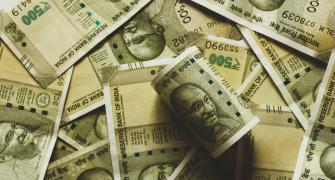It's a fairly common occurrence nowadays to see industry grumbling about inadequate bank credit. It's a little unusual to see a banker retorting in such fine form, as Punjab National Bank chairman K C Chakrabarty did at a recent Confederation of Indian Industry bankers' conference the week before last in Mumbai.
"May I point out sir," he said, glancing around and at the CII representatives on the dais, "We have shown sustained year-on-year credit growth. My credit growth at this point is 38 per cent and my lending rate is 100 basis points lower than the largest bank and 300 bps lower than the second-largest bank in the country." And, he added, without skipping a beat, "as it happens, we are the third largest bank in the country."
The 38 per cent number was a bit of a surprise to all seated. And before one could ask how or why, Mr Chakrabarty thundered, "You say banks are not lending but you don't say which banks. You are not saying these are the same banks that got the best-bank awards year after year."
As it happened, the whole might of the government descended on the private banks in subsequent days, i.e. last week. Even the Prime Minister referred to the liquidity conditions. And if the banks are still treading gingerly, times must be tough. And yet, how times change.
Here's why. Let's rewind a bit, to around 2003-04. These were, as you will fondly recall, epochal days for borrowers and lenders alike. Interest rates had begun their glorious descent into unheard of levels. These were the rates (and times) when folks I used to meet in parties were buying second and planning third houses. In Kochi. "How come, thought you hailed from Pune?" "Because it's cheap, and it will appreciate."
Salaries had begun rising and people were saying - it's a Rs 20 lakh (Rs 2 million) apartment so I need to put Rs 200,000 to Rs 400,000 down. The balance, well, it will cost me only Rs 18,000 to Rs 20,000 a month. It was not the price of real estate that mattered, it was the equated monthly instalment that caused deals to fly.
Getting a loan was not so challenging. There were any number of Direct Sales Associates who were throwing themselves at you. Sometimes they pounced on you as you emerged from an airport (credit cards) or cold-called you to submission.
What prompted the near free-for-all in interest rates then in contrast to the sheer trepidation to lend now? Surely not because of prodding by the Prime Minister, finance minister or the Reserve Bank governor. I do not recall any exhortations to lend or lower interest rates, at least not publicly. And yet they did. And set the stage for the public sector banks to follow.
The answer is quite simple. Apart from a favourable cost of funds equation, it was pure competition and perceived market opportunity. Banks such as ICICI were keen to make a mark and explore the retail lending model as opposed to the steel industry-weighted institutional model that weighed them down in the mid and late 1990s. To do that, they plunged aggressively into the open market for retail customers.
A low interest rate regime also caused demand for homes to rocket. So did real estate prices, rising between 300 to 400 per cent between 2004 and 2008. So thrilled was everyone with climbing asset prices that the (mostly) private sector banks were now funding both ends of the supply chain - customers and builders. In many cases, builders got private equity as well. Or they raised more funds from a capital market desperate for the 'new growth sector'.
It's a different story now. After having performed the equivalent of a batsman spraying fours and sixes into the pavilions, the banks are now content with taking the odd run or two - never mind the spectators baying for more action. The reasons could include the state of the balance sheets or an unfavourable cost of capital. But I sense it's equally the fear that something could go seriously wrong on the liability side.
There are two takeaways here. First, it was the low interest regime which caused the asset price bubble. And that regime did not happen automatically. As is evident, a combination of market conditions created it. Second, there was a heady 'we are heading for something very big' feeling which is of course now replaced by 'we are heading for a big cliff and we don't know how deep the waterfall is' feeling.
One way or the other, the adventurous lending will begin only when the sense of competitiveness and market share returns. For that to happen will require a combination of market conditions that may take their own time. So if one now revisited the real estate industry's demand that interest rates should be lowered to spur demand, you may conclude, as I have, that it sounds a little ridiculous.
The private banks won laurels because they pulled the banking system out of a decades-long stupor, combining technology and aggressive marketing to win customers. Now the shoe is on the other foot - try and catch a current Bank of Baroda television commercial showing a prospective bride speaking to the boy in an 'interactive voice response' tone. It's the kind of ad that makes you laugh. It also tells you that winning awards this year will take more than cool technology and integrated IVR systems.
The writer is Editor of UTVi Business. He has dealings with two 'award-winning' banks






